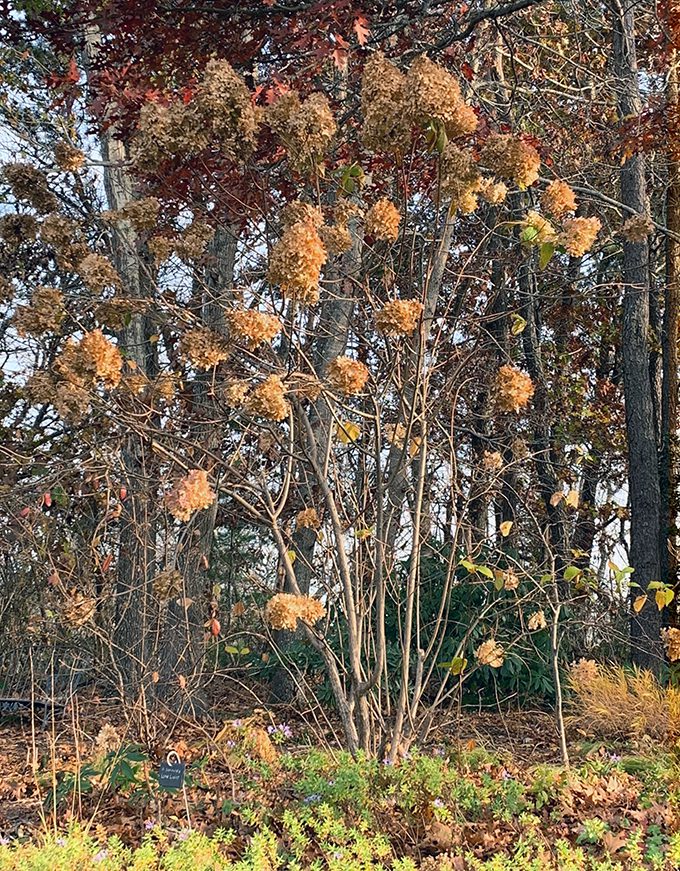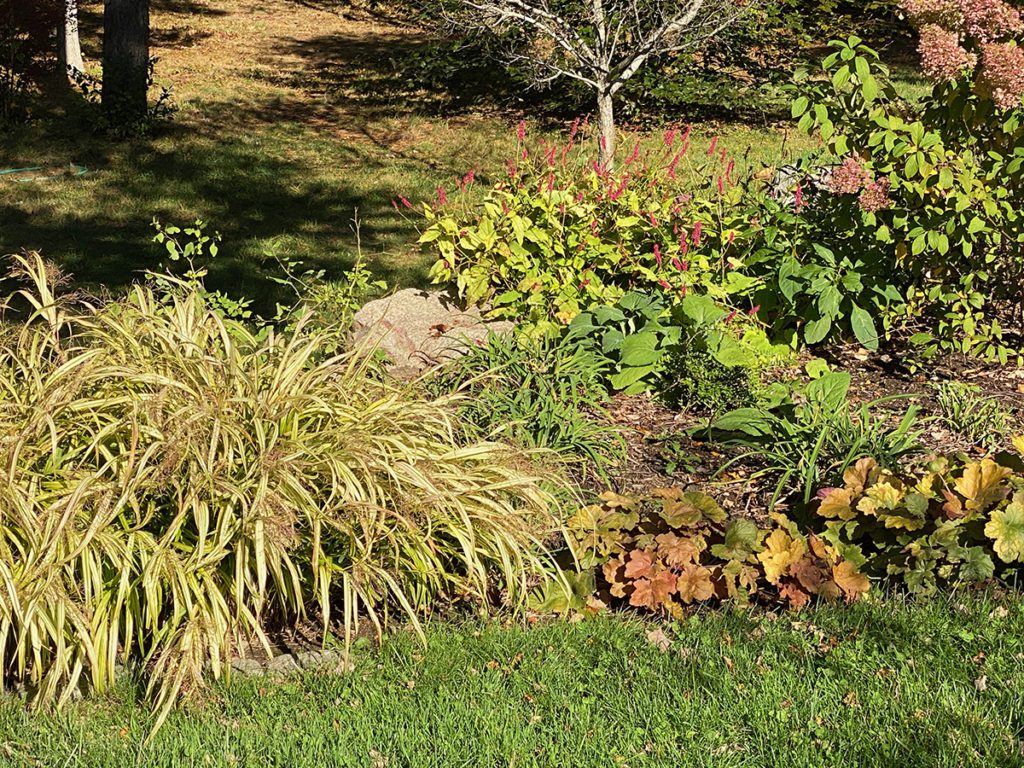Fall Clean Up and Perennial Q&A
Fall Clean Up and Perennial Q&A
This week’s post is about fall cleanup. At the end I answer some of the questions that came in during the Zoom presentation about perennial garden maintenance.
Cutting Brown Hydrangea Flowers Off One common question we hear is from people wondering if they should cut the brown flowers off of their hydrangeas. This is optional. If you don’t like how they look, by all means snip them off just below the dried bloom. But most of them will fall off in the winter anyway, so it’s up to you.
Pruning Hydrangeas In Fall? Do NOT prune hydrangeas in the fall, and never cut your blue hydrangeas back in the fall to “neaten them up” – that results in shrubs that have green tops (because they grow just as tall in one season) and few flowers. The only pruning you should do on your blue or pink mopheads and lacecaps is to remove dead canes or tops of stems in late-May.

Cutting Grassed Down Another common question is if ornamental grasses should be cut down in the fall. In general, it’s better to wait until sometime between February and April, but if your grasses are huge and falling in inconvenient places, go ahead and cut them down now. Newly planted grasses tend to get established faster if you leave them standing over the first winter, however.

Leaves “Do I have to rake up the leaves that fall on my lawn and flower beds?” There is no hard and fast rule here, but there are guidelines. Piles of leaves that get trapped on turf can smother the grass in the spring once they become wet and packed down, so you might want to remove the leaves where they accumulate thickly. Leaves that gather around shrubs and perennials can also harbor voles and mice that feast on your plants during the winter, so this is another reason to rake them away. Some leaves on the lawn can also be used to amend your soil; run the lawnmower over them several times and leave the tiny pieces on your lawn to compost in place.
The reality of oak leaves on Cape Cod is that we’re usually raking them again in the spring anyway since many of these trees don’t drop all their leaves until the end of winter.
Perennial Bed Cleanup: Some people like the look of a perennial garden that has been cleared in the fall, while others prefer to leave the stems and leaves until next year. There are advantages to both methods, so do which suits your time and style best.
A general guideline is to leave any perennial that has foliage that looks alive and capable of photosynthesis at this time of year. If the leaves are clearly performing a function for the plants (creating energy) they are usually attractive as well. Heuchera (coral bells) and Epimedium are a good examples of perennials that look good into and through the winter.

These are some of the questions that were asked during the Perennial Garden Maintenance virtual talk last weekend.
Patty: Do you cut peonies back now? Can they be separated too?
Peonies can be cut to the ground anytime from the end of August into the fall. The best time to divide them or transplant the whole clump is in the fall. When you replant peonies, find the place where the old stems joined the top of their thick roots and cover that with about 2 inches of soil. Peonies don’t like to have their crowns (where the stems join the roots) buried too deeply, although you shouldn’t plant them so the roots show. Peonies can be divided (separated) in the fall, but they usually don’t need dividing in order to flower well. They are one of the perennials that can be left in the same location for years.
Joann: Do you remove your hosta foliage after the first frost?
This is up to you. Hosta leaves and stems die back flat in the fall, and you can either rake them out in the fall or spring, or cover them over with your spring mulching. (Perennial mulch should be about an inch or two, but not more. Don’t pile the mulch around the stems of perennials as it can keep the crowns too moist.
Paul: When dividing perennials, do you split the plant?
Perennials that produce several stems coming up out of the ground can be divided. You can either use your shovel to chop off pieces of the clump about the size of a dinner plate, or you can pop the entire plant out of the ground and then use your shovel or spade to cut through the roots, dividing it into pieces. Perennials that have one central stem and are more shrub-like, such as lavender, cannot be divided.
Jane: When is the latest time of year to fertilize lilies?
The last time to fertilize lilies is in late August or early September.
Robin: cut clematis to ground? Leaves brown and falling off since July.
This summer’s heat and drought have taken a toll on many plants. If you are sure the plant is dead to the ground you can cut it back to about six inches tall in the fall. But you might want to just trim off the top third and see if the vines put out new growth from the remaining stems next spring. If you don’t see any green growth off those stems by late May, cut them to the ground. If the roots lived, you should see growth from the ground in May.
Kelly : how do I take care of stink horn mushrooms in a perennial garden 🤮
Just ignore stink horn fungi. They come and go quickly and harmless.
Trisha: What does gout weed look like?
Photo here! This is a really nasty weed. There is a variegated form that some people often call Snow on the Mountain…it is less vigorous but can revert to the green version. This plant is so invasive that it’s illegal to sell in Massachusetts. If you have it in your yard, may The Force be with you!

Jane: Can you add manure/compost on top of leaf coverings?
If the leaves are chopped, or very small, yes. If you have whole oak leaves, however, it would be better to chop them with a lawn mower first.
Wendy: Is seaweed good to use in my composter?
Yes, it’s fine to add seaweed to your compost. The true, fleshy seaweed decomposes the fastest, while eel grass (the stuff that looks like old audio tape) takes longer. Keep in mind that even seaweed comes with weed seeds, however.
Mary: How to keep hibiscus in pot inside? cat eats leaves, can it be in unheated garage?
Tropical Hibiscus doesn’t do well when the temperatures drop below 50. It’s not one of the plants you can store in a cold garage and ignore all winter. Find a sunny window in the house where the temperatures stay above 55, and it will be fine.
Phil: Bunny-resistant perennials?
First of all, when it comes to critters there are no guarantees. As soon as we say that rabbits or deer don’t eat particular plants, someone will find that in their yard these are critter favorites! But in general, perennials that have an herbal odor aren’t bothered by rabbits. This includes Nepeta, Russian sage, yarrow, and most Salvia. Poisonous plants such as foxglove and monkshood are also ignored.
Lynn: Why does autumn joy sedum splay out. definitely not too much water this year.
Sedum Autumn Joy is prone to splaying open when the heads get very large and heavy. This can happen with regular watering, in soil that is quite fertile, and in places that aren’t getting at least 8 hours of sun a day. Note that there are several new varieties of sedum that don’t flop. Look for Autumn Charm and Pure Joy, for just two examples.
Subscribe To Our Newsletter
Sign up for our weekly email about sales and events.
